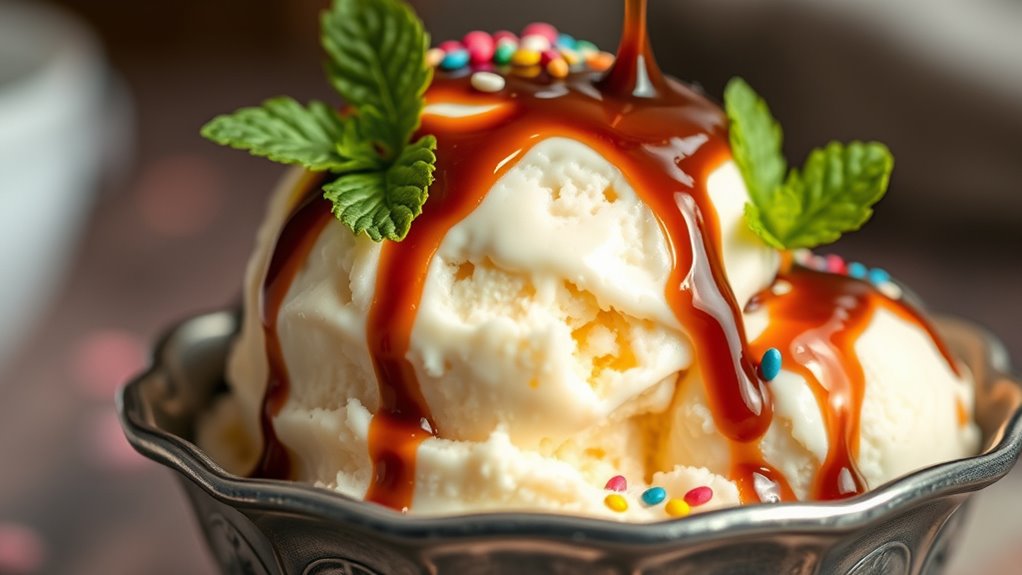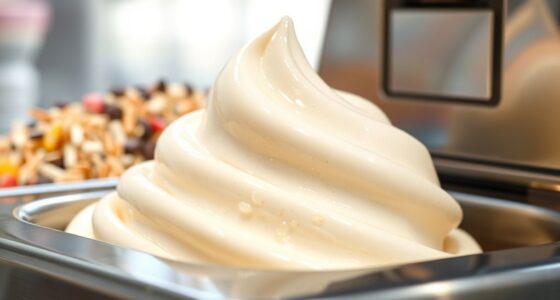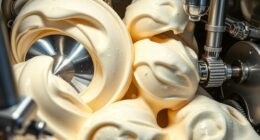Stop making these ice cream mistakes by choosing high-quality ingredients and properly chilling your mixture before freezing. Avoid overmixing or undermixing, and always use stabilizers or emulsifiers for a smooth texture. Properly store your ice cream at consistent, cold temperatures and protect it from air and odors. Don’t forget to use your churning equipment, serve at the right temperature, and keep your tools clean. Keep these tips in mind, and you’ll see how much better your ice cream becomes.
Key Takeaways
- Use high-quality ingredients and ensure proper chilling for optimal texture and flavor.
- Properly churn your mixture to achieve a smooth, creamy consistency.
- Store ice cream at consistent, cold temperatures in airtight containers to prevent freezer burn and odors.
- Serve at the correct temperature (6°F to 10°F) for ideal scoopability and flavor.
- Maintain equipment and plan batches carefully to ensure consistent quality and prevent contamination.
Using Low-Quality or Incorrect Ingredients

Using low-quality or incorrect ingredients can substantially ruin the texture and flavor of your ice cream. Your ingredient selection directly impacts the final product, so choose fresh, high-quality items whenever possible. Poor-quality dairy or flavorings can lead to off-putting tastes and a gritty or watery texture. Ensuring proper quality control means checking expiration dates and sourcing ingredients from reputable suppliers. Avoid substituting ingredients without considering their effect on texture and flavor, as this can cause unwanted results. Remember, even a small difference in ingredient quality can make or break your ice cream. Prioritize fresh, premium ingredients and maintain strict quality control to achieve a smooth, creamy, and delicious outcome every time. Additionally, understanding the importance of ingredient purity can help you select the best components for a superior product.
Skipping the Proper Chilling Process

Skipping the proper chilling process can substantially compromise the texture and consistency of your ice cream. When you neglect adequate temperature control, your mixture won’t set correctly, resulting in a grainy or icy final product. To guarantee ideal results, focus on these key steps: 1. Chill the base thoroughly in the refrigerator for at least 4 hours or overnight. 2. Use a thermometer to monitor the mixture’s temperature, aiming for around 40°F (4°C). 3. Allow the ice cream to freeze in the coldest part of your freezer, ideally between -10°F and -20°F (-23°C to -29°C). Ensuring proper air circulation within your freezer can also help maintain a consistent temperature and improve overall freezing performance. Additionally, filter maintenance of your freezer can prevent dust and debris buildup that might impede optimal airflow. Regularly cleaning your freezer’s vents and coils can further enhance airflow and freezing efficiency. Proper temperature monitoring is essential for achieving smooth, creamy ice cream with the right texture. Moreover, understanding the importance of temperature consistency can help prevent unwanted ice crystals from forming during storage.
Overmixing or Undermixing the Base

Overmixing or undermixing the ice cream base can lead to undesirable textures and inconsistent results. If you overmix, the mixture may become too aerated, resulting in a light, icy texture instead of creamy smoothness. On the other hand, undermixing can cause poor ingredient distribution, leaving chunks or uneven flavor throughout. Achieving the right mixing consistency is essential to guarantee all ingredients are evenly incorporated without introducing excess air. Pay attention to the texture as you mix—stop once the base is uniform and smooth. Proper mixing helps distribute fats, sugars, and flavorings evenly, leading to a consistently rich, velvety ice cream. Avoid rushing the process or overdoing it; precision at this stage makes a noticeable difference in your final product.
Forgetting to Use Stabilizers or Emulsifiers

Skipping stabilizers or emulsifiers can lead to a less smooth texture and icy spots in your ice cream. These ingredients help improve quality by preventing ice crystal formation and ensuring a creamy consistency. Forgetting them might mean ending up with a less enjoyable frozen treat. Additionally, understanding resources and tools available can help you select the best stabilizers for your recipes. Incorporating appliance technology, such as ice cream makers with built-in features, can further enhance your results and reduce the likelihood of common mistakes. Using the right ingredients and techniques is essential for achieving professional-quality ice cream at home. Recognizing proper ingredient ratios can also make a significant difference in overall texture and flavor. Being aware of essential oils for texture improvement might also provide innovative ways to enhance your ice cream’s mouthfeel and stability.
Enhances Texture Quality
When you forget to include stabilizers or emulsifiers, your ice cream may turn grainy or icy, ruining its creamy texture and smooth consistency. To improve texture quality, consider these key points:
- Incorporate stabilizers like guar gum or carrageenan to prevent ice crystal formation and maintain creaminess. These ingredients help in texture stabilization by controlling ice crystal growth during freezing. Incorporating commercial stabilizers can further enhance the quality of your homemade ice cream.
- Use emulsifiers such as lecithin or egg yolks to create a uniform mixture, ensuring a smooth finish.
- Balance fat and sugar levels, as they help keep the ice cream soft and velvety.
- Incorporate natural ingredients that help improve consistency and enhance flavor stability.
Prevents Ice Crystals
Without stabilizers and emulsifiers, your ice cream is more prone to developing large ice crystals during freezing. These big crystals can ruin the smooth, creamy texture you’re aiming for. Stabilizers and emulsifiers work by interfering with ice crystal formation, helping keep the crystals small and evenly distributed. This process is essential for texture preservation, ensuring every bite remains silky and consistent. Skipping these ingredients increases the risk of a grainy, icy mouthfeel. Incorporating stabilizers like gelatin, xanthan gum, or egg yolks helps maintain a desirable texture by controlling ice crystal growth. Emulsifiers also improve the mixture’s stability, preventing separation. Properly balanced stabilizers and emulsifiers can also contribute to air circulation within the ice cream, enhancing its overall structure and mouthfeel. Additionally, using these ingredients can help improve the overall quality of your homemade ice cream, making it more enjoyable. For best results, understanding how these ingredients interact with your mixture can lead to a more consistent texture and a superior final product. Ultimately, using stabilizers and emulsifiers is a simple way to make your homemade ice cream smoother, creamier, and more pleasurable to enjoy.
Ignoring the Importance of Proper Storage Temperatures
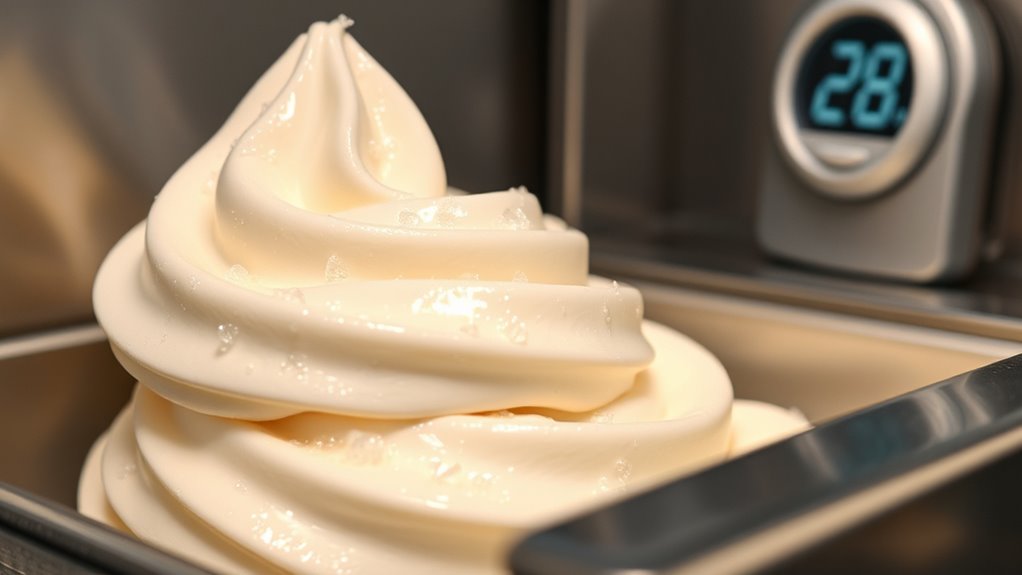
Proper storage temperatures are crucial for maintaining ice cream’s quality and safety, yet many people overlook this detail. Incorrect temperature control can lead to texture changes and spoilage. To ensure ideal storage conditions, keep in mind:
- Store ice cream at or below -18°C (0°F).
- Avoid temperature fluctuations by maintaining a consistent freezer setting.
- Use a thermometer to monitor storage conditions regularly.
- Consistent temperature control helps prevent ice crystal formation, which can ruin the texture and mouthfeel of your ice cream.
Failing to adhere to these guidelines allows ice cream to develop ice crystals and become gritty. Proper storage conditions preserve the creamy texture and prevent bacterial growth. Remember, neglecting temperature control not only compromises flavor but also poses health risks. Paying close attention to your freezer’s temperature is a simple yet effective way to keep your ice cream at its best.
Not Protecting Ice Cream From Air and Odors
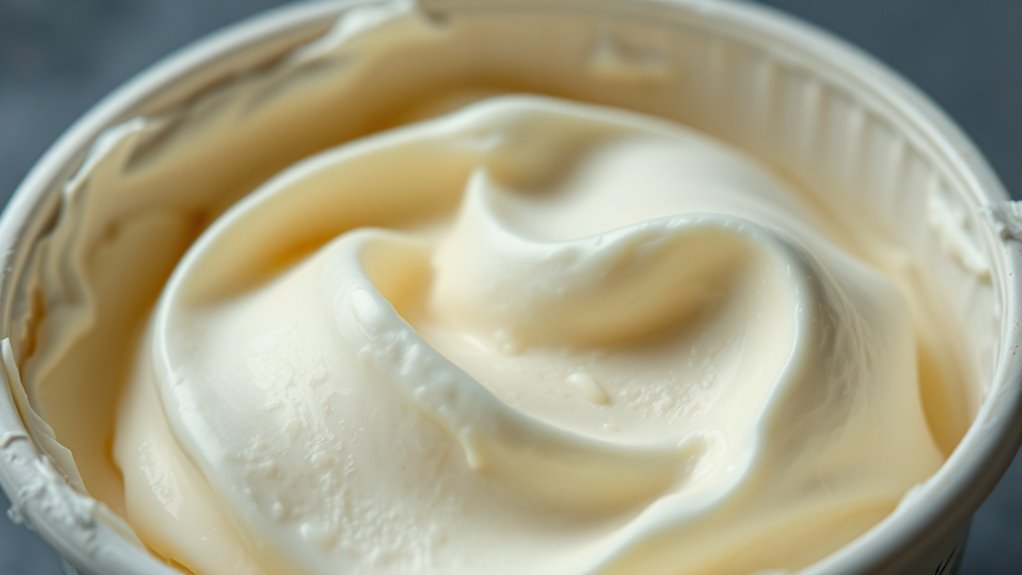
If you don’t seal your ice cream properly, it can quickly absorb unwanted air and odors. Always use airtight containers to keep your ice cream fresh and tasting great. Proper sealing makes all the difference in maintaining its quality. Additionally, storing ice cream at a consistent temperature helps prevent freezer burn and spoilage. Incorporating smart home utilities like smart thermostats can help maintain optimal freezer conditions and extend the shelf life of your ice cream. Knowing the importance of necessary cookies can also remind you to ensure your freezer environment is consistently optimized for the best storage conditions.
Seal Properly Every Time
To keep your ice cream tasting fresh, make sure to seal the container tightly every time you put it back in the freezer. Proper ice cream sealing prevents air and odors from compromising container freshness and preserves flavor. To guarantee a perfect seal:
- Check that the lid fits snugly without gaps.
- Press out excess air before sealing to minimize freezer burn.
- Consider wrapping the container with plastic wrap for an extra barrier.
- Using an airtight container can further enhance freshness and prevent unwanted odors from seeping in. Additionally, ensuring that your freezer maintains a consistent temperature can help prevent freezer burn and preserve your ice cream’s quality over time. Proper sealing practices are essential for maintaining the freshness and overall quality of frozen foods.
Use Airtight Containers
Using airtight containers is essential for keeping your ice cream fresh, but simply choosing a container labeled as “airtight” isn’t enough if it doesn’t actually seal tightly. You need to guarantee proper sealing every time you store ice cream to prevent air from sneaking in. Air exposure causes freezer burn and ice crystal formation, ruining texture and flavor. Invest in high-quality airtight containers that create a secure seal and double-check that the lid clicks into place. When sealing, press firmly around the edges to eliminate any gaps. Avoid leaving the container partially open or loosely covered. Proper sealing locks out odors and moisture, helping your ice cream stay creamy and delicious longer. Using the right airtight containers with proper sealing is a simple but crucial step in ice cream storage.
Relying Solely on Freezing Without Churning

Relying solely on freezing without churning often leads to ice cream that’s overly icy and has a gritty texture. Without proper churning techniques, your ice cream won’t develop a smooth, creamy consistency. To improve texture enhancement, you should:
Freezing alone creates icy, gritty ice cream—churning is essential for a smooth, creamy texture.
- Use a machine that incorporates air, giving your ice cream a lighter feel.
- Mix ingredients thoroughly to ensure even distribution of fats and sugars.
- Churn the mixture for the right amount of time to prevent large ice crystals from forming.
Skipping this step makes the ice cream dense and difficult to scoop. Churning breaks up ice crystals during freezing, resulting in a more velvety consistency. Don’t underestimate the power of proper churning techniques for better texture and overall quality.
Serving at the Wrong Temperature

Even if you’ve perfected your churning process, serving ice cream at the wrong temperature can ruin its texture and flavor. The ideal serving temperature for ice cream is typically between 6°F and 10°F. If it’s too cold, the ice cream becomes hard and difficult to scoop, dulling its flavor. On the other hand, if it’s too warm, it melts quickly, losing its creamy consistency and causing a messy presentation. Your ice cream temperature should be just right to make certain it’s soft enough to enjoy without melting instantly. Use a thermometer to check the serving temperature, and if needed, let it sit out a few minutes before serving. Proper serving temperature enhances the overall experience and keeps your ice cream tasting its best.
Forgetting to Clean and Maintain Your Equipment
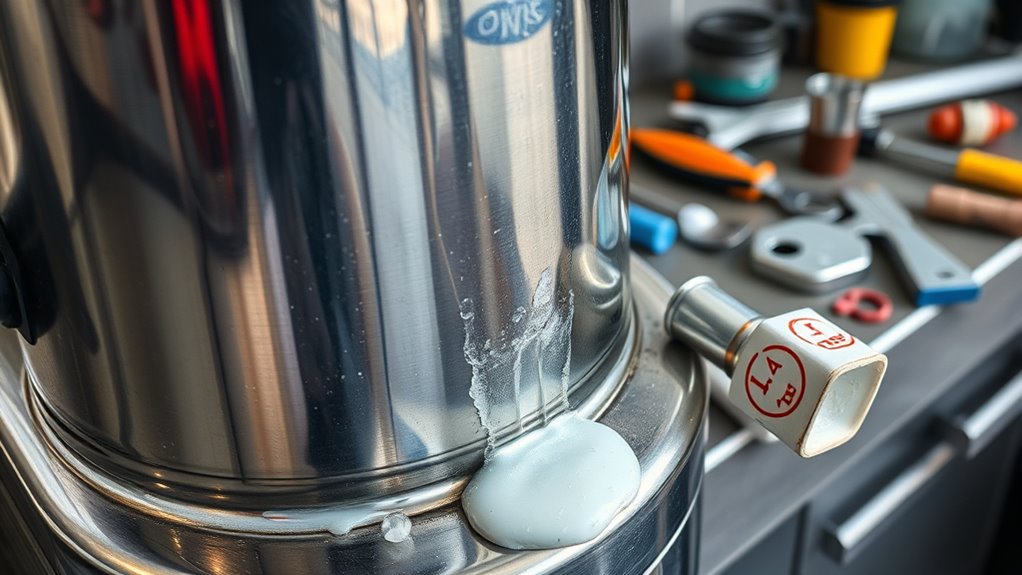
Neglecting to clean and maintain your ice cream equipment can lead to contamination, off-flavors, and poor texture in your final product. Ensuring proper equipment hygiene and following maintenance routines are essential for quality. To keep your equipment in top shape:
Neglecting equipment maintenance risks contamination, off-flavors, and poor ice cream quality.
- Regularly disassemble and thoroughly clean all parts to prevent residue buildup.
- Use appropriate cleaning solutions to eliminate bacteria and mold.
- Schedule routine inspections to identify wear or damage that could affect performance.
Skipping these steps can compromise your ice cream’s taste and safety. Maintaining your equipment not only prolongs its lifespan but also guarantees your ice cream remains fresh, smooth, and delicious. Prioritize proper hygiene and maintenance routines—they’re indispensable for consistent excellence.
Making Large Batches Without Proper Planning
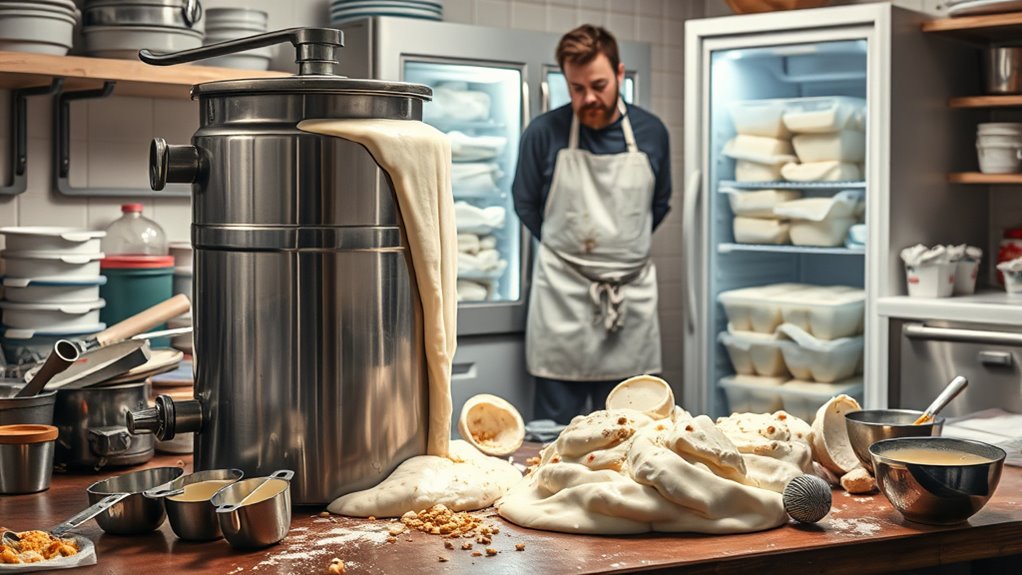
Making large batches of ice cream without proper planning can lead to significant issues, such as inconsistent texture, wasted ingredients, and logistical headaches. You need to carefully consider your batch size to ensure it fits your equipment and storage space. Improper ingredient scaling can throw off the balance of flavors and texture, resulting in ice cream that’s overly soft or too hard. Before you start, plan your recipe proportions precisely, adjusting ingredient quantities according to the batch size. This prevents shortages or excess, saving you time and money. Failing to coordinate your batch size with your equipment’s capacity can cause overflows or incomplete mixing. Proper planning guarantees consistent quality, minimizes waste, and makes the entire process smoother. Always double-check your ingredient scaling and batch size before beginning.
Frequently Asked Questions
How Does Ingredient Quality Affect Ice Cream Texture and Flavor?
Your ingredient sourcing directly impacts both ice cream texture and flavor. High-quality ingredients create a smoother, creamier texture and richer flavor, while lower-quality options can lead to graininess or off-flavors. When you choose fresh, premium ingredients, you’re enhancing flavor and ensuring a better mouthfeel. This attention to ingredient quality makes a noticeable difference, helping you craft ice cream that’s more indulgent and satisfying for everyone who enjoys it.
What Are Common Signs of Overmixing or Undermixing the Base?
Ever wonder if you’re overmixing or undermixing your ice cream base? If you notice texture inconsistencies or a grainy feel, it’s likely you’ve missed the mark. Overmixing can lead to a dense, icy texture, while undermixing leaves you with uneven flavor and air pockets. Pay close attention to your mixing duration—too long or too short—and you’ll craft a smoother, creamier treat every time.
Why Is Stabilizer or Emulsifier Addition Crucial for Ice Cream Quality?
Adding stabilizers or emulsifiers is essential because stabilizer benefits include preventing ice crystal growth, ensuring a smooth texture. Emulsifier functions help blend fats and liquids evenly, improving creaminess and consistency. Without these ingredients, your ice cream might become icy or greasy. By incorporating stabilizers and emulsifiers, you enhance the overall quality, making your ice cream more enjoyable and professional-looking with a perfect, velvety mouthfeel.
How Can Improper Storage Temperatures Impact Ice Cream Consistency?
Imagine biting into ice cream that’s icy and crumbly instead of smooth and creamy—that’s what improper storage temperature can do. When your freezer isn’t cold enough, ice crystals form, leading to freezer burn and a grainy texture. Keep your storage temperature consistently low to prevent this, ensuring your ice cream stays luscious and scoopable. Properly stored, it preserves that delightful, velvety consistency you crave.
What Are Best Practices for Cleaning Ice Cream Equipment?
To keep your ice cream equipment in top shape, follow best practices for cleaning. You should regularly implement sanitization protocols to prevent bacteria buildup and make certain of product quality. Additionally, check equipment calibration frequently to maintain proper consistency and temperature control. Always disassemble parts for thorough cleaning, use appropriate cleaning agents, and rinse well. Proper maintenance not only extends equipment lifespan but also guarantees your ice cream remains delicious and safe for customers.
Conclusion
Avoid these common ice cream mistakes, and you’ll be on your way to creamy perfection. But remember, the biggest secret lies in the details you often overlook—those tiny steps that can make or break your batch. Are you ready to discover what truly transforms good ice cream into irresistible? Keep paying attention, because mastering these overlooked tricks might just be the game-changer you’ve been waiting for… and the key to your next unforgettable flavor.
